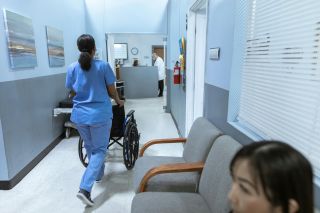Caregiving
Hospitals Can Be Disorienting: How to Help a Loved One
Caring for your loved one after they have been admitted.
Posted April 10, 2024 Reviewed by Lybi Ma
Key points
- Being admitted to the hospital means your loved one may be observed or treated for a while.
- In-person advocacy is most effective for discussing care with nurses, hospitalist, and specialists.
- A call before a nurse's shift ends can also keep you informed about the previous 12 hours and what's next.
- Your caregiver advocacy is both reassuring for your person and pragmatic for improving health outcomes.
From the Emergency Department to the Hospital (Even Though They're in the Same Building)
It’s not always clear what’s happening in a hospital environment. Is your loved one being evaluated in the emergency department, or are they in an observation unit, or have they been admitted to the hospital?
Let's say your loved one is now in the hospital, but you're not sure what that means.
Ask the questions. Find out the name of the floor or unit and where the nurses’ station is located.
If your loved one is admitted to the hospital, in-person advocacy will be most effective. Being in person allows you to meet the nurses, nursing assistants, facility maintenance staff, phlebotomists, respiratory therapists, physical therapists, occupational therapists, other care staff, specialists, and the hospitalist, who coordinates the care team.
What You Can Do

The names of the people who enter the room most frequently may be written on a whiteboard in the hospital room, along with a rating of your loved one as a fall risk. There may be goals written on the board.
Learn the names every day: these people are now your colleagues. If your person is moved to another unit, learn the new names.
Seek out the nurses’ station so you know where to find someone to request an extra blanket for your person or alert them to a change in their condition. When you run out for lunch, and if you can afford it, ask if they’d like something savory or sweet to share among them. They’re human, they may have forgotten to bring lunch that day.
The hospital room itself is uncomfortable for everyone. Your loved one is in a bed that can be adjusted, but that doesn’t mean they’ve found the ideal resting position for the last 24 hours. They’re probably attached to an IV stand. If they walk to the bathroom, the stand must go with them or be detached by a nurse. If they can’t walk to the bathroom, they need a urinal or bedside commode.
Let’s be honest: it's all kind of a drag.
What Else to Expect
Nurses will come into the room to change fluids, medications, and units of blood hanging on the IV stand. Don’t distract them, because no one wants a medical error. But do say thank you and ask how their day is. Also, ask about their favorite snack and whether they like the hospital coffee because you may see them the following day.
The hospitalist and other specialists will likely stop by each day, but you won’t know who will come when. There may be a rhythm to it after a couple of days: for example, being there from 9:00 to 1:00 may be best to catch most of their visits.
These conversations are important for gathering information—both for them and for you and your loved one—otherwise, you will need to decipher their notes later and get a watered-down version from someone else.
But maybe you live in another city or state, or you live across town but can’t leave work or your kids.
There are still ways to be involved in your person’s care in the hospital.
Tracking Progress During the Hospitalization
Whether you are there in person or at a distance, learn the shift changes. It’s typically 8:00 to 8:00 or 7:00 to 7:00. Even if you’re in the same town, you may not get there early enough to see the nurse going off their shift, but you can call a half hour before they leave to see how the night went.
Nurses update the incoming nurse on each patient’s case, but details can get lost in the transfer (and between the transfer and talking to you).
You may want to ask a few questions. Did they have sleeping issues? Were they agitated? Did they have a sudden change in their vitals or their labs? Have the most recent blood labs been taken? What are the doctors looking for? What’s the goal for today?
If your loved one is allowing you to be involved in their care—even better, if they are welcoming it—then you can set up portals to follow their progress, although not all portals are updated automatically. You will be able to view labs and see doctor’s notes.
Having access to this information may be critical beyond the hospitalization as well. We tend to think of health care as an uninterrupted flow of data until we actually deal with it ourselves.
If your person receives all their care in one system—from primary to specialty to emergency—then consider yourself lucky, because you may have access to all their data from one source and online portal. There may even be more coordination within the system because data is easily shared between specialists.
If, however, your loved one receives care from more than one system—say, a clinic by one provider, a hospital managed by another, and specialists by yet other providers—then data is not being shared between them unless you or your loved one are requesting and signing and making certain that data is shared with all of the above (and regularly). Even then, the data is not transferred immediately.
It's messy, but it’s the truth.
Showing Up Is Important
Your loved one may have it all together under normal circumstances, but crises and hospitals are not conducive to clear thinking; your advocacy matters.
There’s no way you can prepare for every eventuality. You’re doing something important just by being in the hospital. Have good food delivered or find a decent cup of coffee.
If a friend wonders how they can help, ask them to have it delivered.




